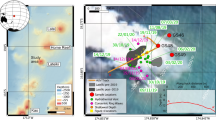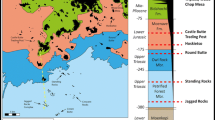Abstract
The Milos volcanic field includes a well-exposed volcaniclastic succession which records a long history of submarine explosive volcanism. The Bombarda volcano, a rhyolitic monogenetic center, erupted ∼1.7 Ma at a depth <200 m below sea level. The aphyric products are represented by a volcaniclastic apron (up to 50 m thick) and a lava dome. The apron is composed of pale gray juvenile fragments and accessory lithic clasts ranging from ash to blocks. The juvenile clasts are highly vesicular to non-vesicular; the vesicles are dominantly tube vesicles. The volcaniclastic apron is made up of three fades: massive to normally graded pumice-lithic breccia, stratified pumice-lithic breccia, and laminated ash with pumice blocks. We interpret the apron beds to be the result of water-supported, volcaniclastic mass-How emplacement, derived directly from the collapse of a small-volume, subaqueous eruption column and from syn-eruptive, down-slope resedimentation of volcaniclastic debris. During this eruptive phase, the activity could have involved a complex combination of phreatomagmatic explosions and minor submarine effusion. The lava dome, emplaced later in the source area, is made up of flow-banded lava and separated from the apron by an obsidian carapace a few meters thick. The near-vertical orientation of the carapace suggests that the dome was intruded within the apron. Remobilization of pyroclastic debris could have been triggered by seismic activity and the lava dome emplacement.
Similar content being viewed by others
References
Allen SR, McPhie J (2000) Water-settling and resedimentation of submarine rhyolitic pumice at Yali, eastern Aegean, Greece. J Volcanol Geotherm Res 95:285–307
Angelier J, Cantagrel JM, Vilminot JC (1977) Néotectonique cassante et volcanisme plio-quatemarie dans l’are égéen interne: l’Ile de Milos (Grèce). Bull Soc Géol Fr 19:119–121
Bigazzi G and Radi D (1981) Datazione con tracce di fissione per l’identificazione della provenienza dei manufatti di ossidiana. Riv Sci Preistoria 36:223–250
Cande SC, Kent DV (1995) Revised calibration of the geomagnetic polarity time scale for the Late Cretaceous and Cenozoic. J Geophys Res 100:6093–6095
Cas RAF, Wright JV (1991) Subaqueous pyroclastic flows and ignimbrites: an assessment. Bull Volcanol 53:357–380
Cashman KV, Fiske RS (1991) Fallout of pyroclastic debris from submarine volcanic eruptions. Science 253:275–280
Clough BJ, Wright JV, Walker GPL (1981) An unusual bed of giant pumice in Mexico. Nature 289:49–50
D’Angelo G, Gargiullo S (1991) Guida alle conchiglie del Mediterraneo. Fabbri, Milano, pp 1–223
D’Erasmo G (1924) Su alcuni fossili dell’isola di Milos raccolti dal Dott. R Sonder. Zeitschr Vulkanol 8/4:230–237
Druitt TH (1995) Settling behavior of concentrated dispersions and some volcanological applications. J Volcanol Geotherm Res 65:27–39
Fisher RV (1984) Submarine volcaniclastic rocks. In: Marginal basin geology. Geol Soc Lond Spec Publ 16:5–27
Fiske RS, Matsuda T (1964) Submarine equivalents of ash flows in the Tokiwa Formation, Japan. Am J Sci 262:76–106
Fiske RS, Cashman KV, Shibata A, Watanabe K (1998) Tephra dispersal from Myojinsho, Japan, during its shallow submarine eruption of 1952–1953. Bull Volcanol 59:262–275
Fytikas M (1977) Geological map 1:25,000, Milos. IGME
Fytikas M, Giuliani O, Innocenti F, Marinelli G, Mazzuoli R (1976). Geochronological data on Recent magmatism of the Aegean Sea. Tectonophysics 31:29–34
Fytikas M, Innocenti F, Kolios N, Manetti P, Mazzuoli R, Poli G, Rita F, Villari L (1986) Volcanology and petrology of volcanic products from the island of Milos and neighbouring islets. J Volcanol Geotherm Res 28:297–317
Houghton BF, Wilson CJN (1989) A vesicularity index for pyroclastic deposits. Bull Volcanol 51:451–462
Johnson RW, Everingham IB, Cooke RJS (1981) Submarine volcanic eruptions in Papua New Guinea: 1878 activity of Vulcan (Rabaul) and other examples. In: Johnson RW (ed) Cooke-Ravian volume of volcanological papers. Geol Surv Papua New Guinea Mem 10:167–179
Kano K (1996) A Miocene coarse volcaniclastic mass-flow deposit in the Shimane peninsula, SW Japan: product of a deep submarine eruption? Bull Volcanol 58:131–143
Kano K (1998) A shallow-marine alkali-basalt tuff cone in the Middle Miocene Jinzai Formation, Izumo, SW Japan. J Volcanol Geotherm Res 87:173–191
Kano K, Yamamoto T, Ono K (1996) Subaqueous eruption and emplacement of the Shinjima Pumice, Shinjima (Mocshima) Island, Kagoshima Bav, SW Japan. J Volcanol Geotherm Res 71:187–206
Kokelaar BP (1986) Magma-water interactions in subaqueous and emergent basaltic volcanism. Bull Volcanol 48:275–289
Kondopoulos DP, Pavlides SB (1990) Paleomagnetic and neotectonic evidence for different deformation patterns in the South Aegean Volcanic Arc: the case of Melos Island. In: Proc Int Earth Science Congr Aegean Regions, 1–6 October 1990, Izmir, Turkey
Kornprobst J, Kienast JR, Vilminot JC (1979) The high-pressure assemblage at Milos, Greece. Contrib Mineral Petrol 69:49–63
Lowe DR (1982) Sediment gravity flows. II. Depositional models with special reference to the deposits of high-density turbidity currents. J Sediment Petrol 52:279–297
Malatesta A (1974) Malacofauna Pliocenica Umbra. Memorie per servire alia descrizione della Carta Geologica d’Italia. Serv Geol Italia vol XIII, pp 1–230
McBirney AR (1963) Factors governing the nature of submarine volcanism. Bull Volcanol 26:455–469
McKenzie DP (1972) Active tectonics of the Mediterranean-region. Geophys J R Astron Soc 30:109–185
McKenzie DP (1978) Active tectonics of the Alpine-Himalayan belt: the sea and surrounding regions (tectonics of the Aegean region). Geophys J R Astron Soc 55:217–254
McPhie J, Doyle M, Allen R (1993) Volcanic textures: a guide to the interpretation of textures in volcanic rocks. CODES, University of Tasmania, pp 1–198
Nicholls IA (1971) Santorini Volcano, Greece. Tectonic relationships with volcanics of the Aegean region. Tectonophvsics 11:377–385
Picard MD, High LR (1973) Sedimentary structures of ephemeral streams. Elsevier, Amsterdam pp 1–223
Piersanti C (1926) I Molluschi e le Conchiglie. Hoepli, Milano, pp 1–511
Renfrew C, Wagstaff M (1982) An island polity. The archaeology of exploitation in Melos. Cambridge University Press, pp 1–330
Reynolds MA, Best JG (1976) Summary of the 1953–1957 eruption of the Tuluman Volcano, Papua New Guinea. In: Johnson RW (ed) Volcanism in Australasia. Elsevier, Amsterdam, pp 287–296
Sabelli B (1980) Conchiglie. Mondadori, Milano, pp 1–502
Shelford PH (1982) The geology of Melos, Kimolos and Polyegos: the stratigraphy. In: Renfrew C, Wagstaff M (eds) An island polity. The archaeology of exploitation in Melos. Cambridge University Press, pp 1–330
Siebe C, Komorowski JC, Navarro C. McHone J, Delgado H, Cortes A (1995) Submarine eruption near Socorro Island, Mexico: geochemistry and scanning electron microscopy studies of floating scoria and reticulite. J Volcanol Geotherm Res 28:297–317
Sonder R (1924) Zur geologie und petrouraphie der inselgruppe von Milos. Zeitsch Vulkanol 8/4:181–237
Swanson DA, Dzurisin D, Holcomb RT, Iwatsubo EY, Chadwick WW, Casadevall TJ, Ewert JW, Heliker CC (1987) Growth of the lava dome at Mount St Helens. Washington (USA), 1981–1983. Geol Soc Am Spec Pap 212:1–16
Tsokas GN (1996) Interpretation of the Bouguer anomaly of Milos Island (Greece). J Volcanol Geotherm Res 72:163–181
Vilminot JC (1977) Présence de roches métamorphiques à glaucophane et lawsonite sur l’île de Milos (arc égéen interne). CR Somm Soc Géol Fr 2:101–103
Author information
Authors and Affiliations
Corresponding author
Additional information
Published online: 30 January 2003
Editorial responsibility: J. McPhie
Rights and permissions
About this article
Cite this article
Rinaldi, M., Venuti, M.C. The submarine eruption of the Bombarda volcano, Milos Island, Cyclades, Greece. Bull Volcanol 65, 282–293 (2003). https://doi.org/10.1007/s00445-002-0260-z
Received:
Accepted:
Issue Date:
DOI: https://doi.org/10.1007/s00445-002-0260-z




